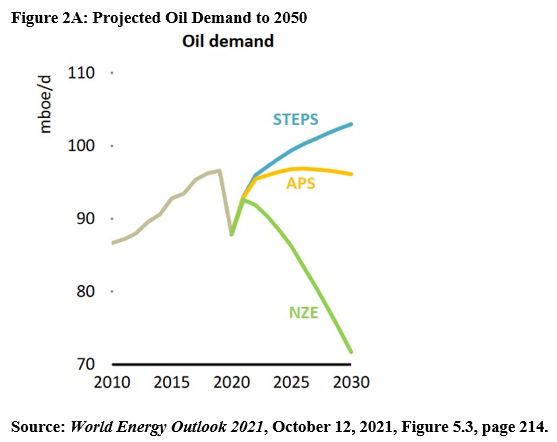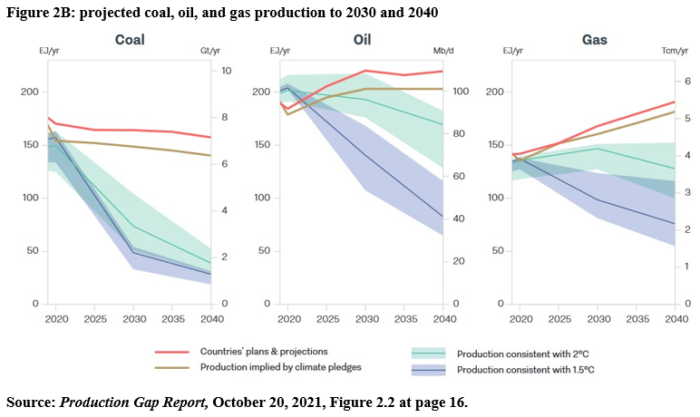Part 2 in a series of 18 discussion papers
The International Energy Agency’s “Net-Zero by 2050 Scenario” (NZE), first published on May 18, 2021, is the leading international study that has examined the magnitude of the reductions in oil production that will be required on a global scale to avoid a catastrophic climate outcome.
The most important contribution of the IEA study was its candid warning about the immediacy of the need to halt any further expansions of oil production, and its detailed conclusions about the rapid pace and severity of the deep cuts in oil use needed by 2030 and by 2040 to give the world even a 50-50 chance to keep the heating of the earth to within the 1.5°C threshold.
Most significantly, it determined that within this decade a 25% reduction in global oil production would be required by 2030, down to 72 million barrels per day (bpd), and that a 50% cut to 44 million bpd must be achieved by 2040. At present, after a brief production decline in 2020 due to Covid, global oil production is now about 100 million bpd.
The IEA’s “NZE” study concluded that global production must further decline to 24 million bpd by 2050 (a 75% reduction) to align with 1.5°C. Furthermore, to meet that goal, 70% of the remaining 24 million bpd of oil production by 2050 will have to be used in applications where the fuel is not combusted and so does not result in any direct CO2 emissions (i.e., used to produce chemical feedstocks, lubricants, and asphalt). By 2050, oil must have very limited use as a transportation fuel except for aviation. Canada’s current plan is to continue increasing our oil production to 2030 and 2040.
The complete divide between the present intentions of our governments and what human beings need to do within the next eight years is depicted in Figure 2A. It shows the path of oil demand under each of the IEA’s three Scenarios. The top blue line of the above graph (“STEPS”, which refers to the IEA’s “Stated Policies Scenario”) depicts the IEA’s most recent projection indicating the rising pathway of global oil production between now and 2030, based on the current plans of Canada and the world’s other oil producing countries.
The “APS” Scenario shows the expected path of global oil production based on “promised” additional future policies and goals by some countries which, if fully implemented and successful, would significantly reduce global oil consumption. But the APS Scenario is highly speculative because it is based on promised future measures that have not yet been developed, or funded, or enacted by regulations, and which therefore remain aspirational. The APS scenario shows that even the most informal promises of future action fall far short of what is required. The sharply declining green line (“NZE”) shows the magnitude of the cuts in overall world oil production that would be needed by 2030 to give us a 50-50 chance of being able to limit global heating to less than 1.5°C.

Another clear warning was given on October 20, 2021, when the UN Environmental Programme and the Stockholm Environmental Institute released their Production Gap Report 2021, which confirms the tragic disconnect between existing plans by the world’s major fossil fuel producing countries (including Canada) to continue expanding production levels and the desperate need to start reductions. The Production Gap Report concluded that “the world’s governments plan to produce more than twice the amount of fossil fuels in 2030 than would be consistent with limiting warming to 1.5°C”. In the specific case of oil production, it states:
Nations are, in aggregate, planning on producing around 40 million barrels per day (Mb/d) more oil than would be consistent with the median 1.5°C pathway in 2030 (with a range of 26-56 Mb/d). This excess is roughly equivalent to half of current global oil production.
— Production Gap Report, October 20, 2021, p. 15
In the case of oil production, the centre graph in Figure 2B below shows that based on oil producing countries’ current plans, between now and 2030 the gap will widen between the deep production decline required to be consistent with the 1.5°C pathway (the bottom diagonal line) and the current expansionary pathway (the top red line).

The most recent updated version of the International Energy Agency’s “Net-Zero by 2050 Scenario” is found in the IEA’s annual report, World Energy Outlook 2022, released on October 27, 2022.
Net-Zero by 2050: A Roadmap for the Global Energy Sector, International Energy Agency(IEA), May 18, 2021: https://iea.blob.core.windows.net/assets/4719e321-6d3d-41a2-bd6b-461ad2f850a8/NetZeroby2050-ARoadmapfortheGlobalEnergySector.pdf
The IEA published an updated version of its NZE Scenario on October 27, 2022:
World Energy Outlook 2022, IEA, October 27, 2022:https://iea.blob.core.windows.net/assets/830fe099-5530-48f2-a7c1-11f35d510983/WorldEnergyOutlook2022.pdf
UN Production Gap Report 2021, UN Environmental Programme and Stockholm Environmental Institute, October 20, 2021: https://productiongap.org/wp-content/uploads/2021/11/PGR2021_web_rev.pdf